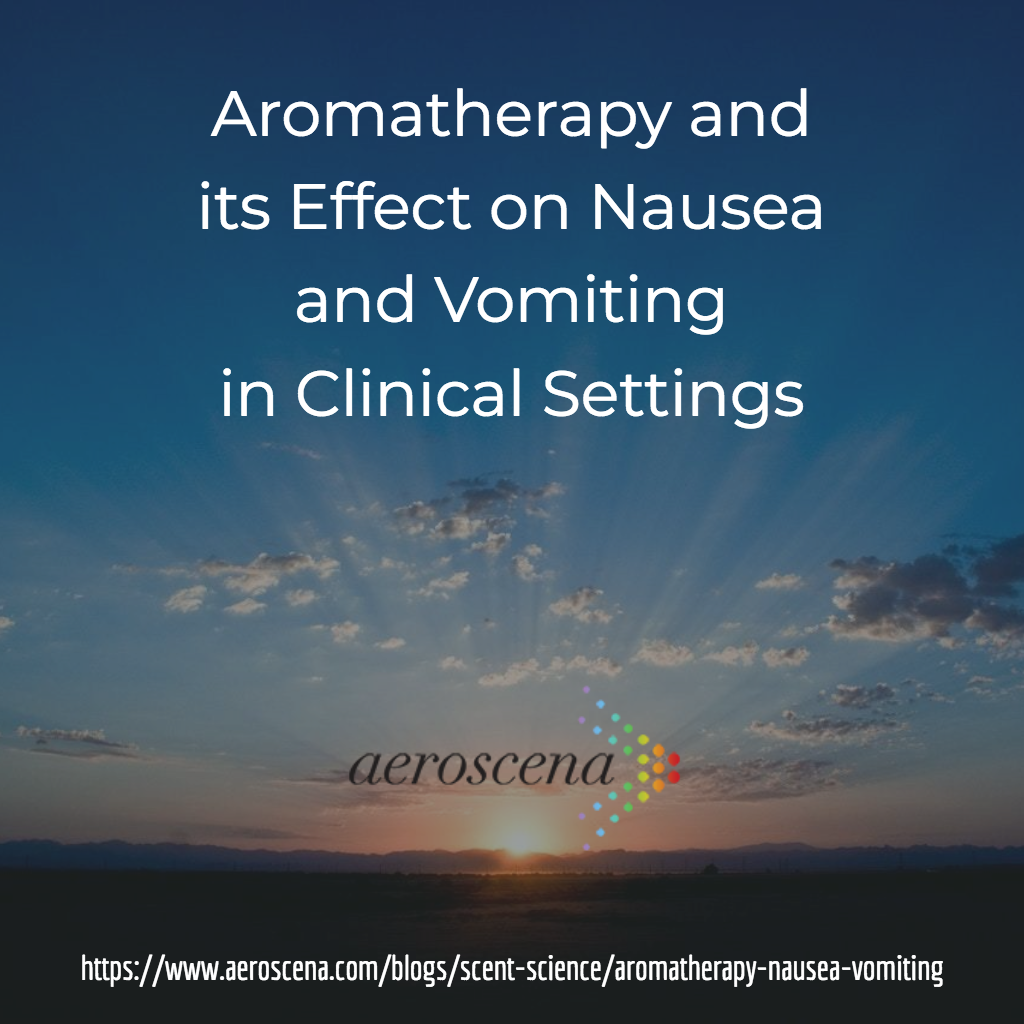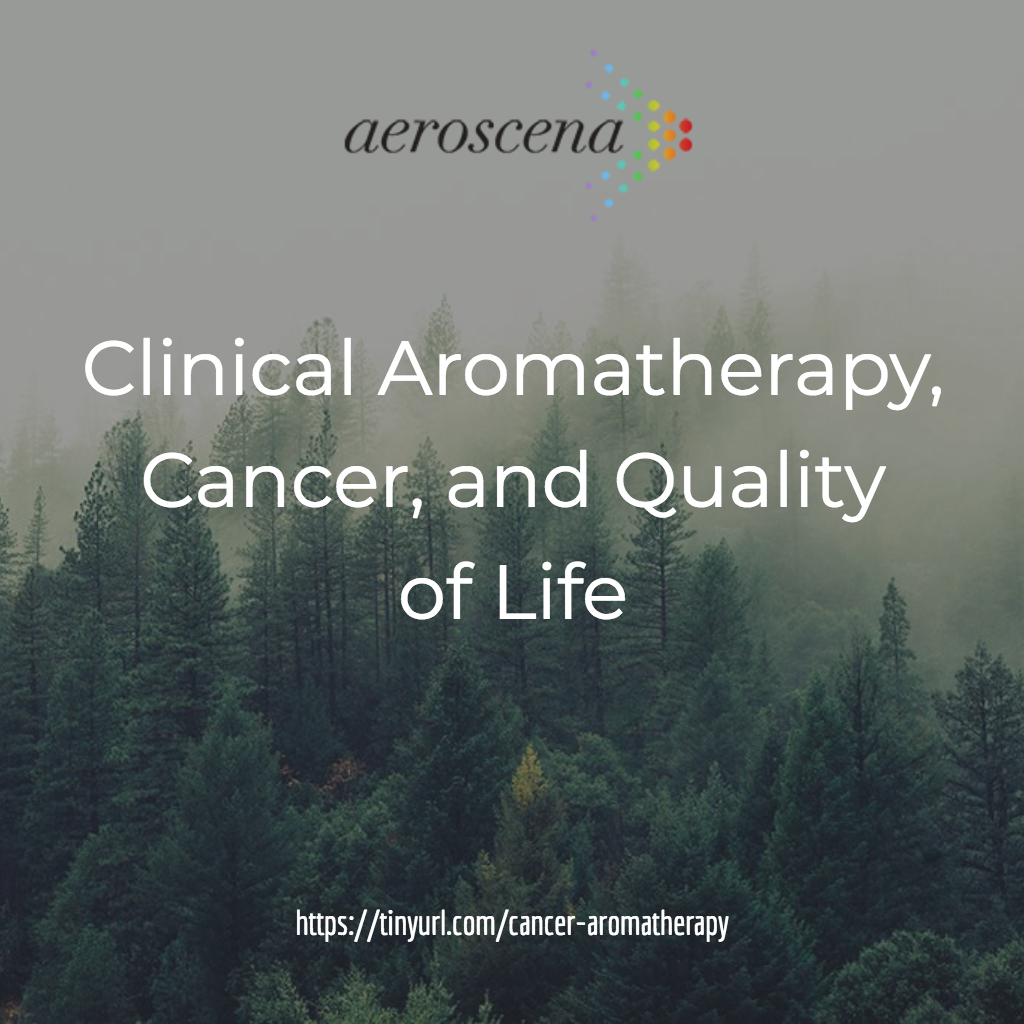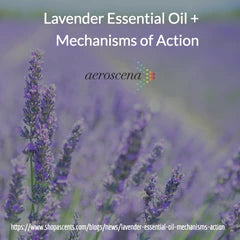
Aromatherapy and its Effect on Nausea and Vomiting in Clinical Settings
 Aeroscena® is in the final stages of a clinical trial for the relief of postoperative nausea and vomiting at the Children’s National Medical Center in Washington DC. As the study draws to a close, we feel it is appropriate to draw attention to the previous research that guided us to this point. These studies are what lead to the creation of our proprietary clinical aromatherapy formula, which is based in large part on high-quality ginger essential oil. The data have shown better efficacy at a lower cost in comparison to the standard pharmaceutical protocol. We look forward to the specifics in the forthcoming paper to be published by the Investigator.
Aeroscena® is in the final stages of a clinical trial for the relief of postoperative nausea and vomiting at the Children’s National Medical Center in Washington DC. As the study draws to a close, we feel it is appropriate to draw attention to the previous research that guided us to this point. These studies are what lead to the creation of our proprietary clinical aromatherapy formula, which is based in large part on high-quality ginger essential oil. The data have shown better efficacy at a lower cost in comparison to the standard pharmaceutical protocol. We look forward to the specifics in the forthcoming paper to be published by the Investigator.
At the core of this performance is the chemical profile of ginger. The constituent chemical composition of essential oils have been examined for decades to gain insight and understanding as to their mechanisms of action. One essential oil of particular interest to the scientific community is Zingiber Officinale Roscoe (Ginger), which has been studied for a wide variety of uses, including as a cancer treatment (1), an anti-inflammatory (2), and an anxiolytic (3)
Of the studied uses, ginger’s use as an antiemetic (4) has drawn notable attention from the medical establishment. Despite historical skepticism, the current consensus based on the best available evidence “demonstrates that ginger is an effective and inexpensive treatment for nausea and vomiting and is safe (4)”.
Under what circumstances is the use of ginger appropriate in clinical settings as an antiemetic? One studied use is for the prevention of PONV, or postoperative nausea and vomiting -- the very condition being studied at Children’s National. Another is in maternity centers to calm queasiness during labor and delivery. A third use is for the mitigation of chemotherapy side-effects, one of the most debilitating of which is nausea.
Ginger and its Constituent Compounds
Ginger root contains 115 unique chemical components. Most of the therapeutic benefits are derived from the phenolic compounds gingerol (23–25%) and shogaol (18–25%), which are found in higher quantity than others. Looking specifically at ginger essential oil, which makes up about 3% of the ginger root plant, that chemical makeup changes, and is instead comprised of approximately 90% sesquiterpenoids, with zingiberene as the primary component.
Other important constituents present in the volatile oil are mono and sesquiterpenes, camphene, β-sesquiphellandrene, β-bisabolene, α-farmesene, curcumene, cineole, citral, terpineol, terpenes, borneol, β-elemene, zingiberenol, limonene, geraniol, zingiberol and linalool (5), many of which are defensive agents that have antibacterial and anti-inflammatory properties.
All of these compounds have been lab-studied and isolated in order to ascertain exactly how and why they work to alleviate various symptoms. Studying these constituents is no different than studying any other chemical substance, and it is work done by the same professional chemists that would study a drug compound. The same holds true for the clinicians overseeing clinical research into the efficacy; they are held to the same strict standards as those studying new pharmaceutical formulations. So what have scientists learned about ginger that has caused it to be studied as a viable medical treatment for nausea?
Ginger as a Treatment for Nausea: Clinical Studies
A 2013 randomized trial examined aromatherapy as treatment for postoperative nausea. The results supported the hypothesis that ginger oil aromatherapy, as well as ginger oil blended with other essential oils, was more effective than saline placebo in reducing postoperative nausea (PONV). The number of antiemetic medications requested after aromatherapy was also significantly reduced with ginger or blend aromatherapy versus saline (P = 0.002 and P < 0.001, respectively) (6).
A 2012 randomized, double-blind study examined the effect of standardized ginger extract on nausea-related quality of life in patients undergoing moderately or highly emetogenic chemotherapy. It found that compared with placebo, adjuvant ginger is associated with better chemotherapy-induced nausea-related and cancer-related quality of life, and less cancer-related fatigue. (7)
In 2017, ginger was studied for its potential to alleviate postoperative nausea and vomiting after laparoscopic cholecystectomy. Multifactor analysis showed that nausea severity was significantly lower in the ginger group vs those receiving intravenous ondansetron(8). A review of literature from the same year examined ginger’s mechanism of action in reducing chemotherapy-induced nausea and vomiting (CINV), concluding that the evidence indicates ginger possesses multiple properties that could be beneficial in reducing CINV (9).
Finally, in 2018, a ginger essential oil blend was studied as a treatment modality to relieve PONV and PDNV in ambulatory surgical patients. It concluded that the ginger blend was an effective way to manage PONV/PDNV (10).
Conclusion
Ginger has been used to quell nausea by herbalists for centuries, but its acceptance in modern clinical settings as an antiemetic will require ongoing time and effort. It is s common to speak with clinicians who dismiss plant-derived medicines as ineffective or “new age.” Aeroscena® will continue to combat this negative view with education, data and a clear presentation of the mechanism(s) of action as demonstrated via scientific study in the manner of contemporary pharmaceutical research.
(1) Ginger and Its Constituents: Role in Prevention and Treatment of Gastrointestinal Cancer
Gastroenterology Research and Practice Volume 2015, Article ID 142979, 11 pages
http://dx.doi.org/10.1155/2015/142979 Sahdeo Prasad and Amit K. Tyagi
Cytokine Research Laboratory, Department of Experimental Therapeutics, The University of Texas MD Anderson Cancer Center, Houston, TX 77030, USA
Accepted 16 February 2015
(2) Anti-Oxidative and Anti-Inflammatory Effects of Ginger in Health and Physical Activity: Review of Current Evidence
Int J Prev Med. 2013 Apr; 4(Suppl 1): S36–S42.
Nafiseh Shokri Mashhadi, Reza Ghiasvand, Gholamreza Askari, Mitra Hariri, Leila Darvishi, and Mohammad Reza Mofid
(3) Identification of serotonin 5-HT1A receptor partial agonists in ginger.
Bioorg Med Chem. 2010 May 1;18(9):3345-51. doi: 10.1016/j.bmc.2010.02.062. Epub 2010 Mar 15. Nievergelt A, Huonker P, Schoop R, Altmann KH, Gertsch J.
(4) The Effectiveness of Ginger in the Prevention of Nausea and Vomiting during Pregnancy and Chemotherapy
Iñaki Lete and José Allué
Integr Med Insights. 2016; 11: 11–17. Published online 2016 Mar 31. doi: 10.4137/IMI.S36273
(5) Zingiber officinale
A.T. Mbaveng, V. Kuete, in Medicinal Spices and Vegetables from Africa, 2017
(6) Aromatherapy as treatment for postoperative nausea: a randomized trial.
Hunt R1, Dienemann J, Norton HJ, Hartley W, Hudgens A, Stern T, Divine G.
Anesth Analg. 2013 Sep; Epub 2012 Mar 5.
(7) The Effect of a Standardized Ginger Extract on Chemotherapy-Induced Nausea-Related Quality of Life in Patients Undergoing Moderately or Highly Emetogenic Chemotherapy: A Double Blind, Randomized, Placebo Controlled Trial
Nutrients. 2017 Aug; 9(8): 867. Published online 2017 Aug 12. doi: 10.3390/nu9080867
Wolfgang Marx, Alexandra L. McCarthy, Karin Ried, Dan McKavanagh, Luis Vitetta, Avni Sali, Anna Lohning, and Elisabeth Isenring
(8) Effects of preoperative administration of ginger (Zingiber officinale Roscoe) on postoperative nausea and vomiting after laparoscopic cholecystectomy.
J Tradit Complement Med. 2017 Jul 18;8(3):387-390. doi: 10.1016/j.jtcme.2017.06.008. eCollection 2018 Jul. Soltani E1, Jangjoo A, Afzal Aghaei M, Dalili A.
(9) Ginger-Mechanism of action in chemotherapy-induced nausea and vomiting: A review.
Marx W, Ried K, McCarthy AL, Vitetta L, Sali A, McKavanagh D, Isenring L.
Crit Rev Food Sci Nutr. 2017 Jan 2;57(1):141-146.
(10) A Comparison of Aromatherapy to Standard Care for Relief of PONV and PDNV in Ambulatory Surgical Patients
Lois M.Stallings-Welden DNP, RN, CNS; Mary Doerner MSN, RN, CPAN, CAPA; Elizabeth (Libby) Ketchem MS, BSN, RN, CWS, NE-BC; Laura Benkert BSN, RN, CAPA; Susan Alka RN; Jonathan D.Stallings PhD
Journal of PeriAnesthesia Nursing Volume 33, Issue 2, April 2018, Pages 116-128








Leave a comment
This site is protected by hCaptcha and the hCaptcha Privacy Policy and Terms of Service apply.